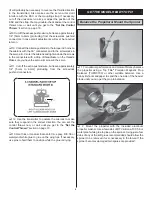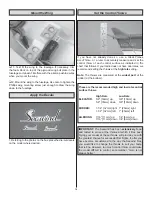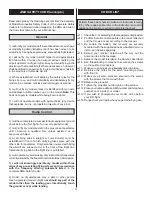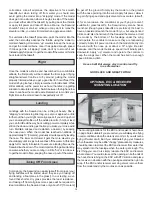
FLYING
The Seawind is a great-fl ying model that fl ies smoothly and
predictably. The Seawind does not, however, possess the self-
recovery characteristics of a primary R/C trainer and should
be fl own only by R/C pilots who have some experience.
CAUTION (THIS APPLIES TO ALL R/C AIRPLANES): If,
while fl ying, you notice an alarming or unusual sound such
as a low-pitched "buzz," this may indicate control surface
fl utter. Flutter occurs when a control surface (such as an
aileron or elevator) or a fl ying surface (such as a wing or
stab) rapidly vibrates up and down (thus causing the noise).
In extreme cases, if not detected immediately, fl utter can
actually cause the control surface to detach or the fl ying
surface to fail, thus causing loss of control followed by
an impending crash. The best thing to do when fl utter is
detected is to slow the model immediately by reducing
power, then land as soon as safely possible. Identify
which surface fl uttered (so the problem may be resolved)
by checking all the servo grommets for deterioration or
signs of vibration. Make certain all pushrod linkages are
secure and free of play. If it fl uttered once, under similar
circumstances it will probably fl utter again unless the
problem is fi xed. Some things which can cause fl utter are;
Excessive hinge gap; oversized holes in servo arms or
control horns where the pushrods connect, Excessive free
play in worn servo gears; Insecure servo mounting; and
one of the most prevalent causes of fl utter; Flying an over-
powered model at excessive speeds.
Preflight
Monitor and limit your fl ight time using the timer in your transmitter
or the timer on your wrist watch. When the batteries are getting
low the motor will usually provide a brief warning before the ESC
cuts off motor power, so when you notice the plane fl ying slower
you should land. Often (but not always!), after the motor cuts off,
power can be briefl y restored after holding the throttle stick all
the way down for a few seconds.
To avoid an unexpected dead-stick landing on your fi rst fl ight,
set your alarm or timer 2 to 3 minutes less than the average
fl ight time shown in the “Average Maximum Flight Time”
chart below, for the battery you are using. When the alarm
sounds you can land; or if you are an experienced pilot you
may continue to fl y, planning for a dead-stick landing to see
just how long the motor will run. Circle the plane upwind of
the landing area until the motor quits. Note the run time, and
then land and reprogram your timer.
Average Maximum Flight Time
ElectriFly Power Series 910mAh 11.1V LiPo
8 min
ElectriFly Power Series 1250mAh 11.1V LiPo
10 min
ElectriFly Power Series 1500mAh 11.1V LiPo
13 min
Always be conservative so the motor won’t quit unexpectedly
and you will have enough battery to land under power.
Takeoff
The Seawind is a joy to fl y from water, but there are a few
techniques that should be used to insure success. The most
important thing is to fl y your Seawind the fi rst few times
when the winds are relatively calm–0 to 5 mph is preferred
(especially if fl ying from water!). Later, once you have become
more experienced with your Seawind, you will be able to fl y
it on windier days.
If you’re a little nervous about fl ying from water, it may be a
good idea to make your fi rst fl ights over dry land (see the
“Taking Off From Grass” section on the next page). This
will allow you to get the model trimmed for straight-and-level
fl ight and get a good feel for how it fl ies.
When you get to the pond the fi rst thing you should do (if you
haven’t already performed the lateral balance) is to practice
taxiing the plane at different speeds. Note that holding full
“up” elevator will hold the water rudder down, thus providing
more control. Also note that if you ever need to make a
sharp “U” turn, the Seawind can just about turn around itself
when moving as slow as possible with the motor at an “idle”
rpm. But at higher speeds the ailerons may also be used to
assist in turning. If it is too windy the Seawind will usually
“weathervane” into the wind, making turns across the wind
diffi cult. In these conditions about all you can do is execute
turns at faster speeds (which will require more space), or
avoid windy conditions altogether.
Use these techniques to position the Seawind for takeoff and
to get it back to shore when you’re done. If the Seawind ever
gets into a situation where one of the wings becomes partially
submerged, immediately pull the throttle back to stop its
forward motion. Otherwise, the wing will dig deeper into the
water. This is a rare occurrence, but if it happens more than
once or twice during your taxiing tests this is probably an
indication that it is too windy to takeoff from water.
When conducting higher-speed taxi tests (up to 1/4 to 1/3
throttle), observe which, if any, wing tip drags in the water.
If, after small aileron corrections to level the wings, one wing
tip still has a tendency to “hook,” the opposite wing may need
some weight. Add weight to the “light” tip or remove some of
the weight you may have previously added to the “heavy” tip.
When ready for takeoff, the Seawind must be pointing
directly into the wind–and the stronger the wind, the
more important this will be. Once the model is pointing into
the wind, smoothly advance the throttle to full power while
simultaneously holding some “up” elevator. This will keep the
nose up, the water rudder submerged, stabilize the plane
and allow it to rise up out of the water without skipping. While
the model is building speed, if necessary, use the ailerons
to level the wings and use the rudder to make heading
14

































